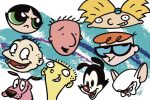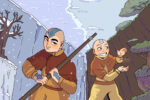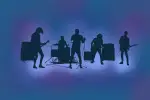Go back to a time when all kids needed on a Saturday morning was a bowl of Fruity Pebbles and their favorite cartoons. Children would get lost watching Disney Channel, Nickelodeon and Cartoon Network as their parents slept in. In many ways, cartoons like “SpongeBob SquarePants,” “Kim Possible” and “Codename: Kids Next Door” defined a generation of young viewers. But what happens when preteens start to outgrow childish shows?
Okay, maybe nobody actually outgrows “SpongeBob,” but there is another category of cartoons that most kids aren’t allowed to watch.
Late at night, shows like “Rick and Morty” and “Family Guy” wake up once the kiddie cartoons go to sleep. Despite the fact these shows are on syndicated networks, they’re not afraid to get controversial, uncomfortable and inappropriate. After all, they’re designed for grown-ups.
Aside from the outrageous jokes, ridiculous parodies, satirical tones and exaggerated impersonations, it’s hard to deny the level of intelligence behind these shows. Over the past 30 years, television has seen adult cartoons come and go. Some only last one or two seasons before their low ratings get them canceled.
So, what does it take to produce an adult cartoon that can capture a fanbase, transcend pop culture and show incredible longevity? If the answer entails a specific formula, then these five shows have found it.
1. “The Simpsons”
To kick off this list, let’s take a trip to 1989 when a dysfunctional, yellow family aired as a prime-time sitcom. The chaotic bunch would later become some of the most recognizable characters in television history. The hallmark cartoon that started it all is none other than “The Simpsons.”
The key to this cartoon’s longevity is its ability to present perfectly imperfect characters. From Homer’s infamous “D’oh!” to Krusty the Clown’s uproarious laugh, each persona has their undeniably distinguishing traits. These distinctive attributes carry the show’s humor and make it a quotable classic.
The various characters embody just about every societal and cultural stereotype. “The Simpsons” doesn’t hold prejudice over who they make fun. Many of their offensive digs pertain to anyone who classifies themselves under a particular race, religion, sexuality, age or profession.
Also, just about every “Simpsons” character has the green light to make a real world reference pertaining to pop culture, politics or religion. There’re even moments when viewers experience a cartoon-in-a-cartoon, such as when Bart and Lisa watch “Itchy and Scratchy.” Most shows, especially animated ones, never intertwined the fictional with the factual until “The Simpsons.”
Despite their massive success, the show received its fair share of criticism. Groening told Entertainment Weekly that people were complaining about Bart’s disrespectful attitude toward his parents. He said the show also got in trouble when Bart wore an “Underachiever and Proud of It, Man” T-shirt. If only people knew the next level of harshness, nastiness and crudeness of the cartoons that would follow in “The Simpsons” footsteps.
2. “Family Guy”
“Family Guy,” created by Seth MacFarlane, is another show that presents a wacky family. The concept might seem familiar because MacFarlane has always been an avid fan of “The Simpsons.”
“[Matt Groening’s] show redirected the course of where I wanted my professional life to go,” MacFarlane said in a 2014 Entertainment Weekly interview. “I wanted to be a Disney animator, and then ‘The Simpsons’ came out, and in every way — writing-wise, production-wise, timing-wise, animation-wise — it just rewrote the rulebook.”
People often compare the two cartoons to one another because of the similarities in characters, plotlines and humor. There was even a crossover episode called “The Simpson Guy.”
MacFarlane’s admiration for “The Simpsons” shines through in his show, but he’s added a few twists. Instead of having a baby like Maggie, MacFarlane made Stewie, a mischievous baby with an English accent who enjoys plotting schemes. With the help of Brian, the Griffin’s anthropomorphic dog, the duo travel through time, break the law and cause destruction in the town of Quahog. The unusual combination is arguably the show’s favorite set of characters among fans.
“Family Guy” is known for its running gags throughout its 17 seasons, including random fights between Peter and Ernie The Giant Chicken, the Evil Monkey in Chris’ closet and the characters’ nonstop hatred toward Meg. These jokes never get old because their sporadic appearances bring them back to life.
The cartoon also tends to interrupt itself just to make unrelated comparisons. It’s not uncommon to hear Peter start an anecdote with, “It’s like the time I …,” as the scene suddenly jumps to said event. These brief, but hilarious, moments enhance the quality of each episode.
3. “South Park”
The irony behind “South Park” is that the kids in the show act like adults. Even though the main characters are fourth graders, “South Park” is not a children’s show. It’s actually one of the most offensive programs on cable TV.
The boys of “South Park” are everything a child should never try to emulate. Cartman, Kyle, Kenny and Stan disrespect their parents, use cuss words, wreak havoc in their hometown (and abroad) and have conversations about controversial political figures, celebrities and issues.
Throughout its 22 seasons, “South Park” continues to push comedy boundaries in the most insulting ways imaginable. The writers and producers come up with the scripts days before the episodes air in order to stay as up-to-date as possible.
Trey Parker and Matt Stone, the cartoon’s fearless creators, spoke to Vanity Fair about how they make “South Park” a consistent comedy force.
“We’re constantly trying to figure out something new for [‘South Park’] to be,” Parker said. “We come to every season trying to say, ‘All right, what can we do totally differently?’ And that’s part of what makes it fun for us.”
The creators’ experimental and satirical approach never fails to get them into trouble. Everyone, from Michael Jackson to Queen Elizabeth, has received brutal mockery at the hands of the writing staff. They also aren’t afraid to cross the line when it comes to topics like terrorism, abortion, religion and sex.
“Our ethos has always been: if it’s funny, it’s funny. Everyone can be made fun of, and everything should be made fun of if you do it in the right way,” Parker told Evening Standard.
4. “Bob’s Burgers”
“Bob’s Burgers,” created by Loren Bouchard, is the adult cartoon that anyone can watch with their parents. It’s the tamest one on this list in terms of dialogue, characters and storylines, but its innocence doesn’t stand in the way of fun.
“Bob’s Burgers” flips the script on standard cartoon family dynamics. Instead of having a dumb dad who never controls his family, Bob Belcher is the ambitious leader who desperately wants to keep his wife, Linda, and his kids — Tina, Gene and Louise — in order. In contrast, Linda is the dim-witted figure who seems to live in her own world, which is filled with silly songs and corny puns.
One of the show’s most beloved characters is the eldest daughter, Tina. At 13, she’s on the brink of puberty as she gushes over boys, attempts to fit in and worries about other people’s opinions. And she’s just the right amount of awkward.
If you’re not familiar with the show, you might be thinking that Tina probably has a prissy, girlish voice. Nope. Her voice is purely monotoned because she’s played by a man named Dan Mintz.
“When we started I knew that I had a head start because it’s just a gimmick to have my voice coming out of a girl,” Mintz said in a 2013 Phoenix New Times interview. “I think people relate to having someone that is just a little invisible to the world, but you know, wants to make a connection to people.”
5. “Rick and Morty”
Created by Dan Harmon and Justin Roiland, this show revolves around Rick Sanchez, an insane yet brilliant scientist, who drags his naïve and anxious grandson, Morty Smith, through dangerous adventures to interdimensional universes. Whether they’re fighting aliens, cloning themselves or shape-shifting, the pair knows how to keep things interesting.
What sets “Ricky and Morty” apart from other cartoons is its creativity and authenticity. Most episodes take place on a different planet, during a different year, in a different dimension. “Rick and Morty” also follows a sequential plotline, meaning that viewers must watch previous episodes to understand current ones.
The show feels realistic yet completely impractical at the same time. It combines science with humanity to convey interesting relationships between the characters. Rick might be the most intelligent being in the universe, but he’s a drunk who lost touch with his family. Now that he lives with his daughter, Beth, and her family of four, he’s trying to mend what he once broke.
The sci-fi cartoon also exhibits an unhealthy relationship between Beth and her husband, Jerry. Their marriage lacks traditional romance as they stumble through their differences. They always seem like they’re on the verge of filing for divorce.
Although the show first aired in 2013, there are only three seasons, with the fourth coming out in November. “Rick and Morty” took a nearly two-year long hiatus between seasons 2 and 3 due to its intricate storylines and scientific references. The physics, chemistry, biology and anatomy details are accurate enough to please most science enthusiasts.
















